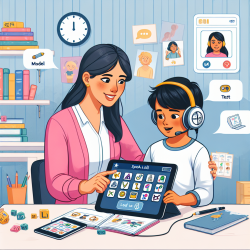As a Special Education Director with a commitment to continuous improvement in educational practices, I often turn to research to find evidence-based strategies that can enhance the learning experience for students with special needs. One such piece of research that offers valuable insights into the development of communication skills and self-esteem in adolescents with learning disabilities is the Communication and Self-Esteem (CASE) Study by M. Ann Marquis and Elaine Addy-Trout.
The CASE study emphasizes the importance of facilitating interpersonal interaction among adolescents with learning disabilities and communication impairments. Grounded in pragmatic language theory and the development of self-esteem, this research provides a structured approach to improving the social skills and self-confidence of students who face unique challenges in their learning journeys.
For practitioners looking to implement the outcomes of the CASE study or delve deeper into the research, here are several key takeaways and strategies:
- Understanding the Link Between Communication and Self-Esteem: The study highlights the interconnectedness of communication abilities and self-esteem. It underscores the critical role that effective communication plays in the overall well-being and self-perception of adolescents. Practitioners are encouraged to foster an environment where students feel safe and supported in expressing themselves, thereby boosting their confidence and self-esteem.
- Pragmatic Language Theory as a Foundation: Drawing on pragmatic language theory, the CASE study offers activities designed to improve the practical use of language in social contexts. This approach goes beyond the mechanics of language to include the use of language in real-life situations, such as understanding social cues, taking turns in conversation, and expressing needs or opinions appropriately.
- Structured Activities to Develop Skills: The study provides a detailed framework for conducting activities aimed at enhancing communication skills and self-esteem. These activities are categorized into ten sections, including Developing a Group Concept, Communicating with Others, and Understanding Oneself, among others. Each activity outlines its language purpose, self-esteem focus, materials needed, vocabulary, and a step-by-step process for implementation.
- Adaptability to Individual Needs: While the activities are designed for adolescents between 12-16 years of age, the language level is approximately at the 10-12 year old level, allowing for adaptability based on the individual needs and abilities of students. Practitioners are encouraged to tailor these activities to suit the varying language and motivation levels of their students, ensuring that each child can benefit from the intervention.
- Role of Professionals in Facilitating Group Interaction: The study discusses the roles of speech-language pathologists, educators, counselors, social workers, and psychologists in using these resources to develop effective interpersonal communication skills. It stresses the importance of experienced and flexible group leaders who can navigate the diverse needs of students and facilitate meaningful group interactions.
Implementing the insights from the CASE study in educational settings requires a thoughtful approach. Practitioners should consider the unique profiles of their students, including their language abilities, self-esteem levels, and social skills. By creating a supportive and inclusive environment, educators can encourage students to engage in activities that build their communication skills and self-confidence. Regular feedback and positive reinforcement are essential components of this process, helping students recognize their progress and feel valued for their contributions.
Moreover, collaboration among professionals is key to the successful implementation of the CASE study's outcomes. Sharing experiences, strategies, and challenges with colleagues can lead to a more cohesive and comprehensive approach to supporting students with learning disabilities and communication impairments.
For practitioners interested in exploring this research further and incorporating its findings into their practice, I highly recommend reviewing the original study. It offers a wealth of information and practical tools that can make a significant difference in the lives of adolescents struggling with communication and self-esteem issues.
To read the original research paper, please follow this link: CASE (Communication and Self-Esteem Study).










